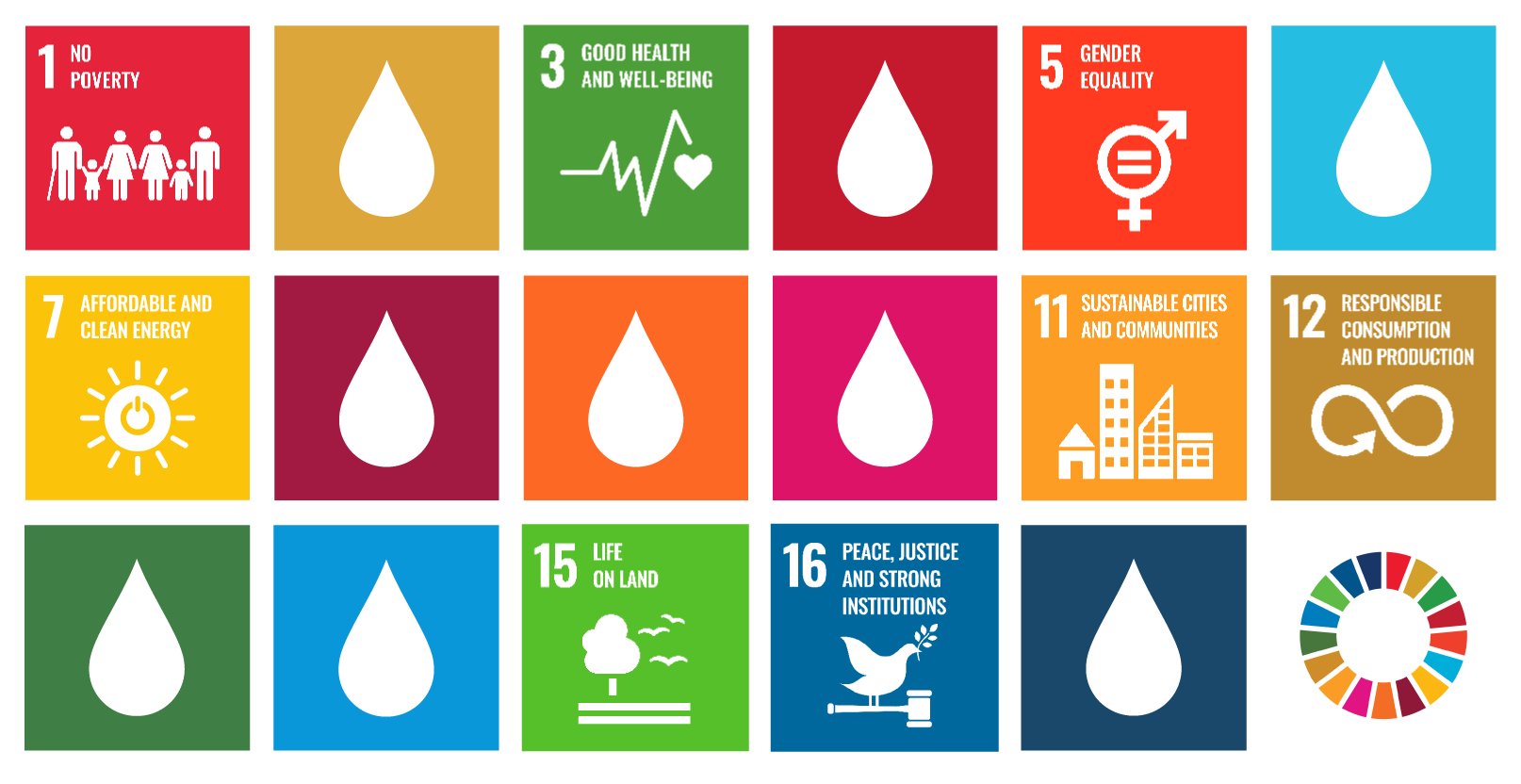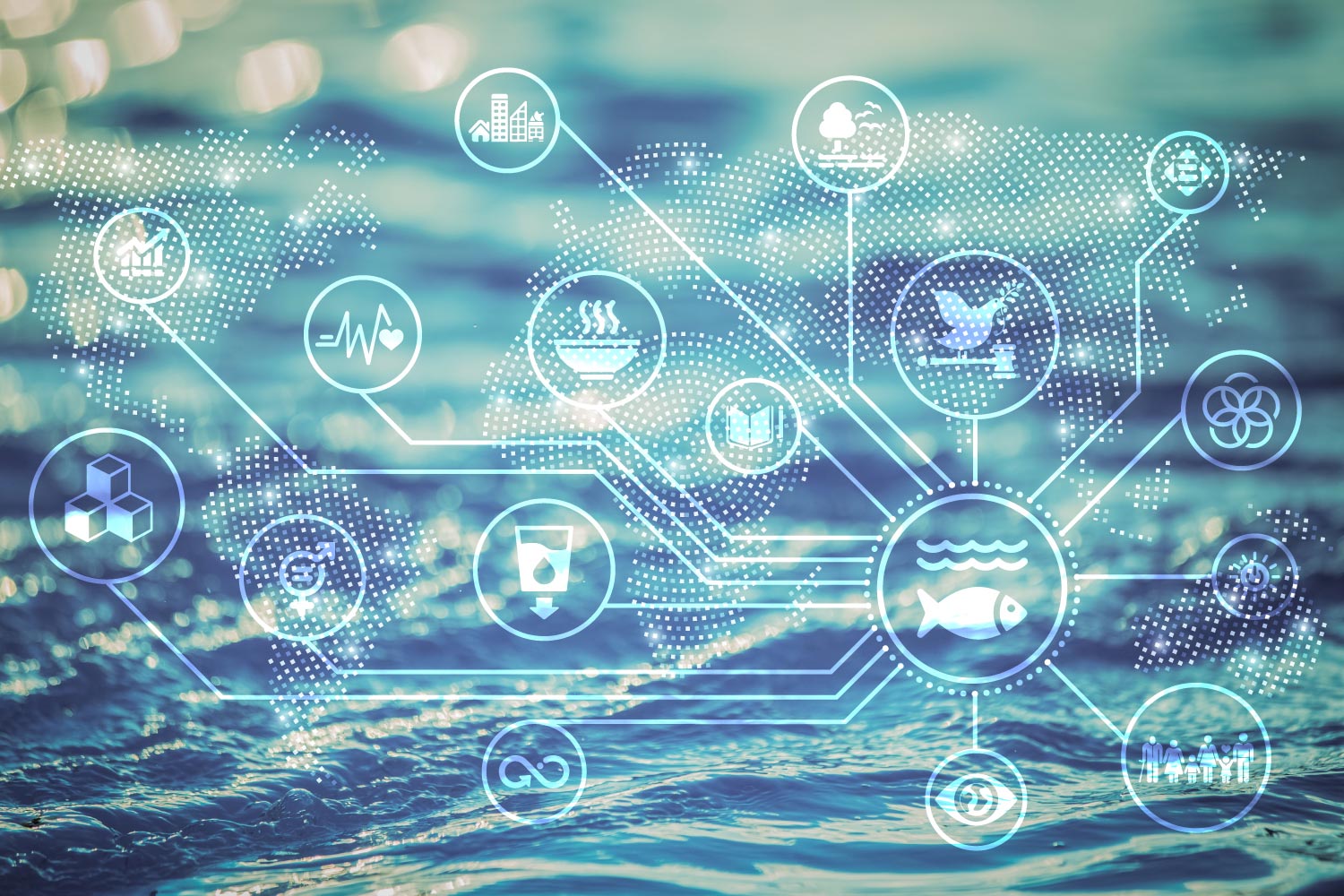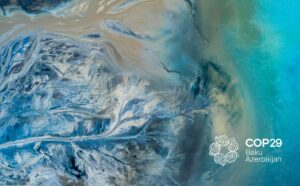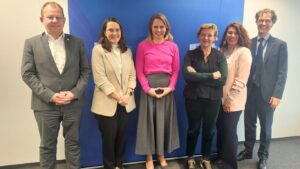- SIWI – Leading expert in water governance
- /
- Latest
- /
- Water is central in achieving all 17 SDGs. But how?
Water is central in achieving all 17 SDGs. But how?

As of today, only 15% of the global targets defined in the 2030 Agenda for Sustainable Development are on track, and many are going backwards. But research shows that policymakers can still ensure that we achieve the 17 Sustainable Development Goals (SDGs). So can we get there? How does water play a role, and why is it so central to all SDGs?
SDG 1 – No poverty
Access to running water removes barriers to economic growth for individuals and societies.
575 million people will face extreme poverty in 2030, with households being deprived of access to essential services, most notably sanitation and drinking water.
Access to running water removes barriers to economic growth for both individuals and society. Being able to wash hands with soap reduces the likelihood of sickness, leading to fewer missed days of work or school, both of which come at great personal economic cost.
Governance and particularly water governance is a prerequisite to improve resilience and populations’ ability to better manage climate related and other risks.
The global goals must recognize the local realities of how poverty is inherently linked to inequalities and the breakdown of social cohesion. Being aware of people in the most vulnerable situations is therefore crucial.
This is exemplified by SIWI’s GoAL-WaterS programme, in collaboration with the Jordan Ministry of Water and Irrigation, began a monumental process to design a national framework as a response to prepare for drought events. Water and lack of access to its connected services is not only an indicator of poverty but also vital to ending extreme poverty and benefiting its related social protection and empowerment.
Learn how water can bring hope in fragile contexts
SDG 2 – Zero hunger
Water-smart agriculture ensures that we are producing more nutrition per drop.
Over 70% of water withdrawals are destined to support agriculture. Ending hunger is more than just about access to food. Effective agriculture and more sustainable practices such as in the Zambezi Watercourse, ensure production of more nutritious food per drop of water.
Likewise, gains in water efficiency make more water available not only for agriculture but also for other purposes. Rainfed agriculture and making use of every drop is crucial, particularly in due to multiple climate stressors.
This is why we need to invest rainfed agriculture
SDG 3 – Good health and well-being
Access to toilets, clean water and soap have immediate benefit on health.
SDG 3 specifically sets out to end all water-borne disease epidemics, such as malaria, by 2030.
Access to clean running water and sanitation facilities immediately contributes to improving public health. It is a cost-effective way of preventing health issues from arising, especially for children under the age of 5 who are more at risk of water-borne diseases. Access to water and sanitation services, for example in public spaces, is key to prevent spread of diseases such as Covid-19.
Learn how SIWI contributes to achieving universal access to water and sanitation
SDG 4 – Quality education
Access to sanitation facilities in schools and quality water education are essentials to create equal opportunities for children.
Schools that incorporate water and sanitation facilities enable children to attend school more regularly and safely. However, the need to fetch water and cultural stigma around menstruation, still keep children, girls in particular, from attending classes.
The relationship between water and education is also a two-way interaction: If provided with quality water education, children can become drivers of change. They can share learnings and good practices in their families, instilling new behaviours in their communities.
Ensuring that children attend school and that they are educated about the interconnection between water, health and other environmental challenges, can help them become more qualified adults who can contribute to future water, sanitation and hygiene services.
Through the WASH-BAT approach, SIWI and UNICEF support communities to assess the constraints that prevent schools from having access to sustainable sanitation and hygiene services.
This is how the WASH BAT methodology is applied in schools
SDG 5 – Gender equality
In education, sanitation, economic growth, climate action… gender transformative leadership helps reduce the gender gap.
Equal access to water is at the heart of achieving gender equality. Women and non-binary people are still disproportionately affected by water insecurity, in part because they often do not enjoy the same tenure rights as men, and they are also more likely to suffer from gender-based violence arising from water insecurity.
Women are often responsible for securing water at the household level, yet their contribution often goes unrecognized within the formal economy. Poverty and lack of empowerment are particularly related to women’s rights and rights to water access. The SDGs need to acknowledge this gender disparity in their acknowledgement of local realities. Providing equal access to water and sanitation services, as well as gender transformative leadership at every decision-making level, are essential for ending the disproportionate risk that women and girls encounter everywhere, every day.
Learn how SIWI works to mainstream gender perspectives in all our work
SDG 7 – Affordable and clean energy
Ramping up renewable energy can reduce water scarcity, minimize pollution, and protect ecosystems.
Water is key to affordable and clean energy and vice versa. Most sources of energy require water for its generation, be it for biomass, hydropower, cooling or emerging fields like hydrogen production.
Functioning freshwater systems are essential for climate mitigation through measures such as bioenergy with carbon capture and storage. On the other hand, water stress can hamper energy production.
Ramping up renewables and boosting energy efficiency can not only reduce emissions but also make water resources that are currently used for inefficient energy generation available for other purposes. Increased energy efficiency in turn contributes to minimizing water pollution and safeguarding aquatic ecosystems.
Understand why water is critical for energy production
SDG 8 – Decent work and economic growth
Good sanitation helps reduce barriers for attending work and school. Water also opens new avenues for decent work and economic growth.
All workplace environments must provide water access and sanitation facilities. Water not only enables productivity, but it also supports nearly any economic activity. Water opens new avenues for decent work and economic growth. Specialized workforces within WASH (water, sanitation and hygiene), entrepreneurship for new water solutions and more circular economic approaches are a crucial part of the economy and work of tomorrow.
International finance and investment are also essential to improve water governance.
The Global Commission on the Economics of Water has showed this important connection amply in highlighting the underpricing of water as well as the enabling role of water for trade.
Water is not only critical for economic growth but can also drastically hinder economic activity and decent work when extreme weather events reduce economic growth and increase inequalities, keeping in mind the link between water related economic activities and GDP growth.
Explore the relationship between water and economics
SDG 9 – Industry, Innovation and infrastructure
Considering water when innovating and developing infrastructure ensures truly inclusive innovation.
If innovation is to be inclusive it cannot exacerbate existing issues such as water stress or unequal access to water. Considering water when shaping innovation and developing infrastructure is key to ensuring that no one is left behind.
Likewise, innovation and improved infrastructure can not only increase the efficiency of water and sanitation provisioning but also create new ways of reusing water and creating new applications of previously unusable or unsafe water.
When talking about innovation, we must also be aware that it is not constrained to technologies and infrastructures alone. Innovation is about making changes that have an impact on the ground. Indigenous People have continuously paved the way in this direction.
Learn more about SIWI’s perspective on water innovation
SDG 10 – Reduced inequalities
Universal access to WASH services and inclusive decision-making processes are essential to safeguard people’s livelihoods and protect natural resources.
Marginalized groups are disproportionally affected by climate change and environmental degradation. Yet, they are often excluded from all decisions that affect them, their land or their communities.
These inequalities become deeply visible through excessive and distressing disparity on universal access to safely managed water, sanitation and hygiene.
Truly inclusive governance with a Human Rights Based Approach, is key to reduce inequalities and support the safeguarding of people’s livelihoods and access to natural resources.
Explore how human rights connect to water resources and governance
SDG 11 – Sustainable cities and communities
Achieving a reduction of the environmental impact of cities relies on a sustainable water supply.
The relationship between water and cities is increasingly stressed as the world urbanizes at record speed. By 2050, it is expected that 80 percent of the global population will live in urban areas.
Achieving a reduction of the per capita environmental impact of cities depends upon a sustainable, reliable water supply of adequate quality and quantity. Faced with new water and climate extremes, cities need to radically rethink every aspect of infrastructure, urban planning, and water governance. This requires participatory city planning, sound waste-management and integrated approaches to climate change.
This is how SIWI works to boost urban resilience
SDG 12 – Responsible consumption and production
Reducing the use of water in production, safely managing wastewater at the end of the process and ensuring sustainable consumption to minimize waste help reduce the water footprint.
Responsible production must be comprehensive: from reducing the use of water in the production chain to safely managing wastewater at the end of the process.
Consider food production: 70% of all water goes towards agriculture. Food wastage therefore equals water wastage. This can be applied to any kind of supply chain. Regulating and measuring water use can ensure sustainable production and consumption.
At the end of the production chain, when wastewater is appropriately managed, treated and reused, not only does it reduce pollution and the impact on the environment, but it also minimizes overall water use. This is what we call the water footprint.
This is of particular significance for release of chemicals into water. Improved water governance can influence the way the antibiotics manufacturing industry operates and avoid the spread of antimicrobial resistance. SIWI´s RAMP (Responsible Antibiotics Manufacturing Platform) has developed a framework to help procurers integrate environmental aspects in their production.
Learn how we can better manage our common water resources
SDG 13 – Climate action
We need to prioritize actions that let us both adapt to climate change and reduce its impact.
Sound water management helps humanity to become more resilient to climate shocks. We must prioritize actions that not only help us adapt to climate change but also mitigate its impacts.
Many countries have engaged in enhancing their Nationally Determined Contributions (NDCs), determining targets to reach the Paris Agreement. But more concrete, measurable commitments would be needed to accelerate action.
The journey towards climate security requires massive, cross-sectoral efforts in improved management of water. In a landmark report, SIWI and partners presented the role of water in climate mitigation.
Read the report on the role of freshwater in climate mitigation
SDG 14 – Life below water
A sustainable development depends on conservation and sustainable use of the ocean, marine and freshwater resources.
The degradation of freshwater and marine ecosystems has a direct impact on biodiversity and livelihoods, as many people directly depend on water for food or economic development.
Managing water from source-to-sea is crucial as it provides an integrated approach to not only protect biodiversity in rivers but also addresses the impact on land, coastal areas and the ocean.
This is what a successful implementation of source-to-sea approach could look like
SDG 15 – Life on land
Healthy water systems are crucial to maintaining biodiversity.
Land systems play a critical role in the regulation of greenhouse gases. Healthy forests, wetlands, prairies and sound land management are essential to limit global warming to 1.5 degrees. However, protecting land and the life it hosts is not possible without available freshwater and functional water cycle dynamics.
Forestry and agricultural practices that consider water flows can reduce poverty and address both the climate crisis and the escalating degradation of biodiversity and ecosystems.
Learn more about the role of water in landscapes
SDG 16 – Peace, justice and strong institutions
Fostering cooperation across water resources is essential to build a peaceful and sustainable future.
Climate change is a threat multiplier that increases the risk of conflicts as access to water becomes more difficult. But countries do not tend to fight water wars. Their efforts to address mutual water challenges can instead be a catalyst for peace.
Transboundary water cooperation is a pre requisite to minimize conflicts and their consequences. With increasing populations facing extreme water stress, it is more important than ever that conflicts don’t escalate over the already scarce resources.
Understand how water cooperation can strengthen peace
SDG 17 – Partnership for the Goals
Water is an enabler that helps us tackle all the biggest global challenges of our time.
There is a direct connection between water and our chances of achieving the Sustainable Development Goals. Water is an enabler that helps us tackle all the biggest global challenges of our time. Therefore, cooperation is required across geographical, political, economic and expertise boundaries.
Only by working together, with a unified focus can we, with the help of water, achieve a more sustainable future.
Water can help us find a more sustainable path
Improving how we use, manage and govern water is essential to achieve the 2030 Agenda for Sustainable Development as a whole.
Ultimately, progress will require bold decisions and accountability from leaders and from each of us, as a shared responsibility. SIWI provides expertise and builds bridges across sectors to enable stronger and more efficient action.
Water can help us find a more sustainable path. We all need to drive the momentum forward by becoming drivers of change within our own spheres of influence, and include water as a solution for each Sustainable Development Goal.
Water as a catalyst for change
To accelerate the kind of urgent, efficient, and effective action needed to achieve the sustainable development agenda, it is crucial to address interconnectedness.
This is how water connects all SDGs
Most recent

Strengthening the Board of Stockholm Water Foundation (SWF)
- Stockholm Water Prize
- Stockholm Junior Water Prize
- Youth and water
- World Water Week

Water is our future – but Sweden still lacks a comprehensive strategy
- Water and the 2030 Agenda
- Groundwater
- Agriculture and water
- Cities
- Disaster risks and water

Sweden and Japan Join Forces on Water and Climate at High-Level Tokyo Seminar

Water for Climate in Baku






